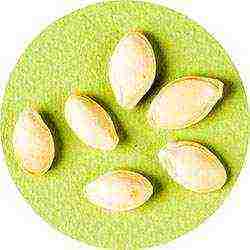Content
Hydrangea is the name of a whole genus of tree-like shrubs, whose representatives are valued for their decorative qualities. Although this plant loves warmth and moisture, planting a serrated hydrangea - one of the species - is widespread in the middle lane. The Blue Bird variety is very beautiful. These sprawling bushes, abundantly decorated with large caps of blue inflorescences, are used to decorate parks and gardens.
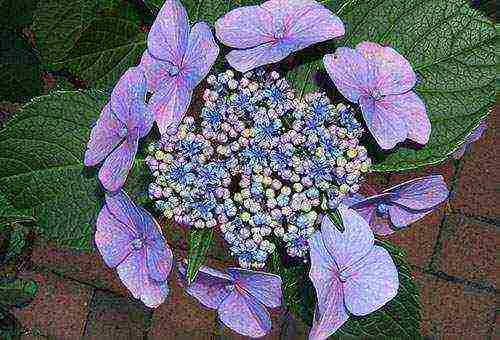
Description
Hydrangea serrata (Hydrangea serrata), like the entire family, comes from Japan. The width of the undersized bush of the Blue Bird variety is about 1.5 m and the height is 1–1.2 meters, which makes the plant look like a green ball. This species is loved by gardeners for the bright colors of the inflorescences and the attractive appearance of the shrub, in addition, it requires simple maintenance. A remarkable feature is that the intensity of the color of the inflorescences can change when the acidity of the soil changes.
The Blue Bird variety, among others, is distinguished by its memorable color scheme: in the center there are small fertile pink, lilac flowers with blue stamens, and at the edges there are large sterile flowers (up to 3 cm in diameter), having a color from pale lilac to bright blue. On acidic soils, the petals become a delicate heavenly shade. The caps themselves have the shape of a flat umbrella, reaching a diameter of 10 cm. The serrated hydrangea has oval leaves serrated at the edges, for which it got its name.
Let's name other features of the plant's appearance.
- The hydrangea bush is deciduous and quite spreading. He likes the abundance of light and moisture.
- It has a strong and branched trunk that is hidden under lush foliage and inflorescences.
- By the way, even young plants planted quite recently bloom profusely.
- The root system of this variety is wide, it is located at a shallow depth in the ground, about 40 cm. Thanks to this, the plant reacts quickly enough to the introduction of mineral fertilizers and organic fertilizing.
If you take proper care of the hydrangea, then it will delight the eye and decorate the site with flowers from July to September. This plant is quite frost-hardy - it can withstand frosts down to -18 ° C and even up to -20 ° C, so it can winter in the ground.
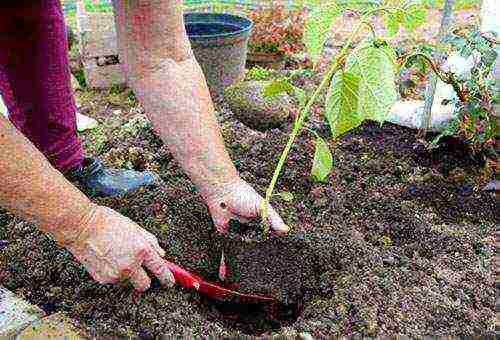
Landing
Planting hydrangeas begins with choosing a suitable location. These are light-loving plants, so they grow well in open spaces, but direct sunlight is destructive for them. Diffused light and partial shade are ideal. Therefore, they can be planted from the southern, eastern and western sides of fences and walls of buildings, which will help decorate and decorate them. It is important that no other plants that love moisture grow within a radius of 3 meters from the hydrangeas, so that there is enough for everyone.
The time should also be chosen correctly - the planting of this shrub should take place in the spring, at the end of April or at the beginning of May. Some gardeners also plant hydrangeas in September when the heat subsides.
Dig a hole 0.5 × 0.5 × 0.6 m in size.If these are group plantings, then the bushes should be at a distance of at least 1.5 m from each other so that each of the plants does not interfere with its neighbor. The pits are filled with soil consisting of the following components:
- humus earth;
- leafy land;
- peat;
- sand.
It is recommended to observe the proportions of the components - 2: 2: 1: 1. Additionally, fertilizers are applied: urea (20 g), mineral complexes and organic matter. It is strictly forbidden to add lime, because hydrangea does not tolerate this type of feeding. When planting, the root collar should be at ground level. Young plants need special care: within 2 years, inflorescences should be removed from them so that nutrients and forces are spent on the formation of green mass. It is also recommended to shelter the seedlings from direct exposure to sunlight, wind and frost.

Care
Hydrangea care is quite simple. It does not require any special skills or knowledge in the field of gardening. This plant is very fond of warmth and moisture, which must be taken into account. In order for more water to get to the root system, it is recommended to regularly loosen the soil around the bush, along with weeding, to a depth of about 5 cm. This will also provide a constant flow of oxygen, which will have a positive effect on the condition of the bush.
Bluebird hydrangea care includes other aspects as well.
- Correct watering. For normal development and abundant flowering, the hydrangea must receive a sufficient amount of water, so it should be watered daily. On hot summer days, when the thermometer rises above + 30 ° C, watering should be done three times a day, and if the air warms up to 25 ° C, then twice (in the morning and in the evening). It is important to ensure that the topsoil is always moderately moist.
- Protection from direct sunlight. Although serrata hydrangea is a fairly light-loving plant, the bright sun can harm it, like most plants. In this case, the earthen lump dries up faster, the flowers become small and pale, and ugly burns appear on the leaves. If the plant is in an open space, then at noon it should be artificially shaded. For example, a removable canopy. Such care allows you to maintain a decorative look.
- Fertilization of a plant occurs in three stages: when planting, when it begins to pick up buds, and at the beginning of flowering. In the last two cases, liquid fertilizers are applied at the root. For example, you can make organic fertilizing by mixing compost diluted in water. The optimal time between feeding is 2 weeks. Fertilizers containing nitrogen and a complex of minerals should be used according to the instructions.
This plant is quite resistant to pests. But it needs to be examined regularly because there is a risk of aphid or powdery mildew infection.
In addition to these basic rules, caring for hydrangea cannot do without pruning and preparing for wintering.
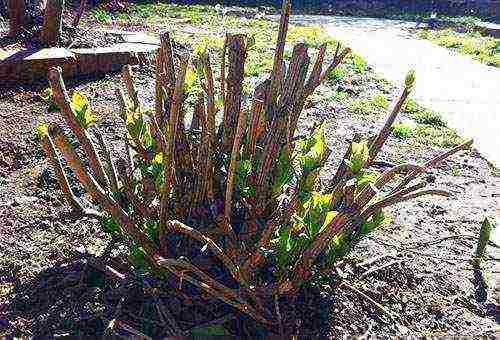
Pruning
Hydrangea serrata requires annual pruning. The best time for this is autumn, when the plant has already bloomed and enters a state of dormancy. You need to use a garden pruner. With the help of such a tool, the upper 2-3 nodes of the shoot are cut off, while trying to give the shrub an elegant "hat" shape. All branches without flowers, dry leaves and dead branches should be removed.
Such care is useful in that after pruning, the area from which moisture evaporates during the winter decreases. Summer trimming of the branches is also allowed to make the bush more branched, lush and even. Also, every two years, a "radical haircut" should be carried out, removing all dead, weak and uneven shoots - this will only benefit the plant, and the hydrangea will be transformed next year.

Preparing for winter
Hydrangea serrata becomes more resistant to frost over time, but at a tender age, these plants need special attention before the onset of cold weather. First you need to cut the bush, it is also recommended to feed it with fertilizer based on phosphorus and potassium.
There are several ways to protect the shrub from cold temperatures.
- Spud the plant and cover with polyethylene (up to -5 ° C).
- Tie the branches with a rope, spud and insulate with spruce branches.For additional protection, you can use several layers of polyethylene, fixed on top with boards (down to -15 ° C).
- Bend bunches of 2 branches to the ground and secure with staples. Then insulate with sawdust, coniferous branches or unnecessary warm things. Withstands temperatures down to -20 ° C.
- Wrap the branches of the bush with a metal mesh or line them with bricks, and throw old warm clothes on top (up to -30 °).
Correctly and timely performed procedures for preparing hydrangeas for winter will guarantee that the plant will wake up healthy with the spring rays of the sun, and will delight you with its flowering caps in the summer.
Hydrangea serrata Blue Bird is a wonderful plant. Correct fit and maintenance is simple enough. With the onset of July, this bush will bloom with bright caps of amazing shades, and will certainly become the main decoration of the garden.
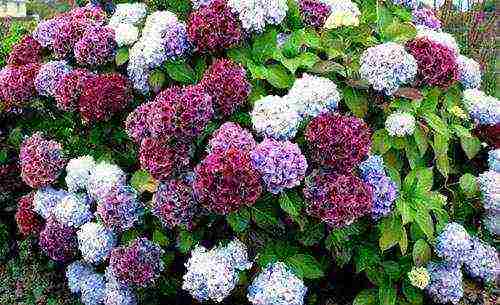 Hydrangea belongs to the family of shrubs, famous for its beautiful spherical inflorescences. It grows in Asian countries, China and Japan. There are more than 70 types of decorative trees and lianas. In Russia, compact garden large-leaved species are most often grown.
Hydrangea belongs to the family of shrubs, famous for its beautiful spherical inflorescences. It grows in Asian countries, China and Japan. There are more than 70 types of decorative trees and lianas. In Russia, compact garden large-leaved species are most often grown.
Types of hydrangeas for summer cottages
 Not all species and varieties are suitable for Russian gardens. Plants are classified as deciduous and evergreen. The latter grow only in regions with a warm climate.
Not all species and varieties are suitable for Russian gardens. Plants are classified as deciduous and evergreen. The latter grow only in regions with a warm climate.
Deciduous species are distinguished by large oval leaves with a pointed tip. The edges of the foliage are flat or jagged, depending on the type of plant.
Inflorescences are divided into types:
- with small petals of both sexes, forming seeds;
- with 4-5 large petals which are sterile.
Hydrangea care includes regularly moistening the soil, fertilizing and pruning the shoots. It is better to plant young plants in early spring, so that they have time to take root and better survive the first winter. Cuttings planted in the fall may die.
The shape of the inflorescences differs depending on the type of flower: in the form of a pyramid, sphere, hemisphere or flat. Fertile inflorescences are located in the center, and sterile flowers are located at the edges. There are varieties in which all inflorescences form seeds, or vice versa, are sterile.
Hydrangea paniculata
 Panicle hydrangea came to us from the Far East. It is a shrub, about 150 cm high. This species grows well in regions of central Russia, and is often used for landscaping and decoration of garden plots.
Panicle hydrangea came to us from the Far East. It is a shrub, about 150 cm high. This species grows well in regions of central Russia, and is often used for landscaping and decoration of garden plots.
Hydrangea flowers reach sizes up to 30 cm in diameter. Bisexual petals are small, after pollination they quickly fall off. Fruitless petals grow up to 3 cm, bloom for a long time, gradually change color from light beige to greenish-pink with a reddish tint.
For full growth, the soil must be clayey, acidic. An alkaline environment leads to disease.
The plant loves moisture, the earth is moistened within a radius of 1.5 m from the trunk. Regular fertilizing with mineral and organic fertilizers is required.
Panicle hydrangea is planted in areas with good sunlight, protected from the winds.
In late February or early March, the branches of the bush are pruned. In order for the shoots to grow faster, their tips are cut off. In order for the plant to bloom magnificently, you need to cut the shoots as short as possible.
Do not prune when buds and leaves appear. Pruning during the period of juice movement weakens the hydrangea, the plant is sick and does not bloom in the current year.
Reproduction of panicle hydrangea
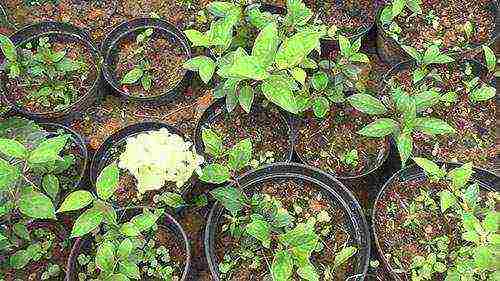 This plant does not lend itself well to reproduction, in order to achieve a positive result, growth stimulants are used.
This plant does not lend itself well to reproduction, in order to achieve a positive result, growth stimulants are used.
Hydrangea paniculata propagates:
- Layers. A deepening is made, the branch is bent to the ground. Throw in a thick layer of soil so that the top remains on the surface. She is tied to a vertical support. After a year, a root system is formed and the seedling can be transplanted. This operation is carried out in the spring or early autumn.
- By cuttings.After pruning, branches are selected that have from 3 to 5 nodes. They are placed in an aqueous solution of weak potassium permanganate for several days. Before planting in the ground, the lower sections are treated with a growth stimulator. Shoots are planted in prepared soil, deepening by 2/3 of the length. Cuttings can be cut from green shoots and planted in pots. The containers are covered with plastic wrap to create a greenhouse effect.
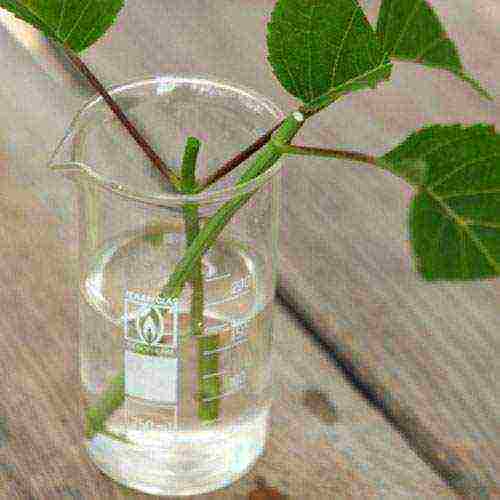 The soil for planting cuttings is prepared from a mixture of 2 parts of peat and 1 part of sand. Peat is poured at the bottom of the container, and sand is poured on it. The stalk is inserted so that it does not reach the bottom layer.
The soil for planting cuttings is prepared from a mixture of 2 parts of peat and 1 part of sand. Peat is poured at the bottom of the container, and sand is poured on it. The stalk is inserted so that it does not reach the bottom layer.
Pots with planted shoots are placed in the basement, the soil is regularly moistened. In the spring, young shoots appear on the cuttings, after which they are planted in a permanent place of growth.
The first three years require more serious care of the hydrangea. Young plants are covered for the winter. They are gradually hardened, becoming resistant to subzero temperatures.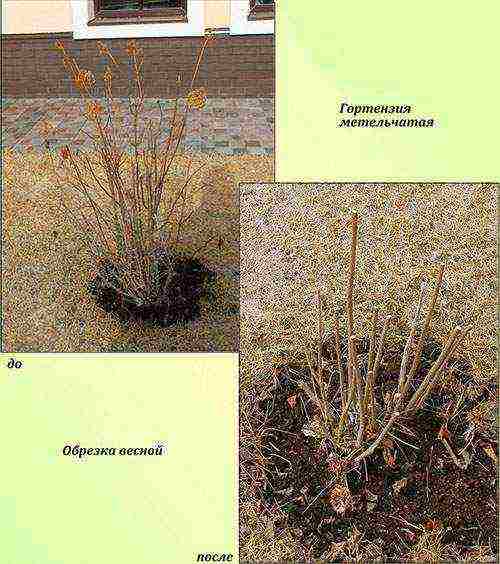
If the hydrangea is frozen, it departs well enough and releases new shoots in the spring.
Hydrangea
The birthplace of the tree hydrangea is North America. The plant is a shrub, reaching a height of 1 to 3 m. It is distinguished by large inflorescences in the form of a ball or triangular panicle. The color is most often white, but it can be cream, pink, blue, depending on the variety and degree of acidity of the soil.
Hydrangea tree has many varieties. Their types, characteristics and photographs are presented in the table:
As you can see in the photo, hydrangea varieties differ in shade, shape and size of inflorescences.
Growing a tree hydrangea
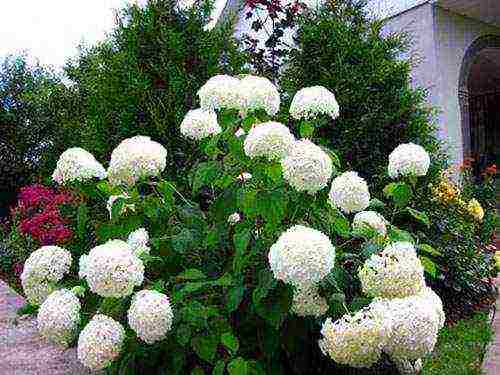 Treelike hydrangea grows well in shady areas with loamy acidic soil. For a group planting of garden hydrangea, the space is marked out so that around each bush there is 2 m of free area.
Treelike hydrangea grows well in shady areas with loamy acidic soil. For a group planting of garden hydrangea, the space is marked out so that around each bush there is 2 m of free area.
The plant reproduces:
- By dividing the bush. You need to be careful not to damage the entire bush. Moisten the soil. 15 cm from the stems, dig in the ground with a pitchfork. The shrub is tilted without removing it from the planting hole. Part of the shoots is cut off along with the root using a sharp knife or a sharpened shovel.
- By cuttings. The cut cutting is placed in water with a weak solution of potassium permanganate for several days. Then they are planted in a soil well fertilized with humus and watered abundantly.
When planting hydrangeas in the ground, the lower 2 leaves are cut off, and the upper shoots are cut off by 2/3. This will prevent excessive evaporation of moisture and the plant will take over faster.
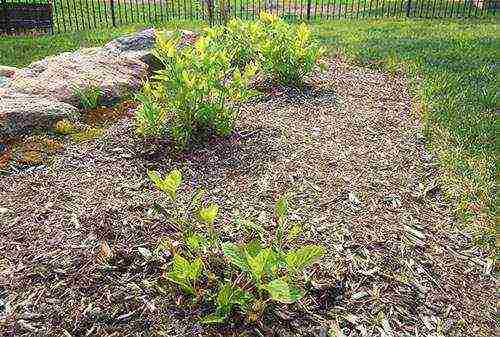 For faster adaptation, a small greenhouse is built from metal or wooden rods, on which a dense plastic wrap is stretched.
For faster adaptation, a small greenhouse is built from metal or wooden rods, on which a dense plastic wrap is stretched.
Pruning of garden hydrangea is carried out in autumn and spring, all cut sites are treated with a manganese solution, and covered with wax on top.
 The hydrangea is planted in a permanent place of growth in the third year.
The hydrangea is planted in a permanent place of growth in the third year.
Nitrogen fertilizers are used with caution, with their high content in the soil, the stem is weakened, the plant's resistance to subzero temperatures decreases, and leads to diseases of the shrub.
Petiolate hydrangea
 An interesting variety of shrubs is the petiolate hydrangea. It differs in that it does not have a trunk, it belongs to the varieties of vines. It is popular for landscape design.
An interesting variety of shrubs is the petiolate hydrangea. It differs in that it does not have a trunk, it belongs to the varieties of vines. It is popular for landscape design.
There are many varieties that differ in leaf shape, color and height. Planting and caring for petiolate hydrangea in the Moscow region is carried out according to the general rules. The plant loves moist acidified soil, does not tolerate the sun's rays, so it is better to plant it in partial shade.
The most popular hydrangea varieties, their photos and characteristics are presented in the table:
| Variety | Characteristics | Photo |
| Petiolaris | The tallest hydrangea with glossy green leaves. It can spread up to 25 m in height. In the absence of support, it spreads along the ground, and upon reaching an elevation creates a semblance of a bush. Inflorescences with a diameter of 20 cm, light cream, corymbose.Looks beautiful as a hedge. | 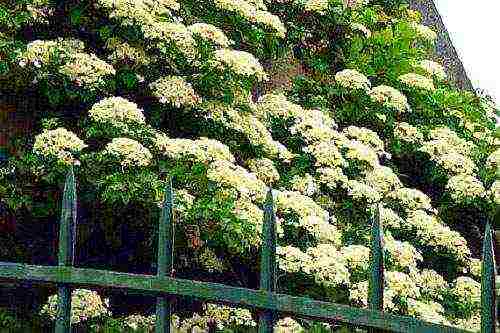 |
| Cordifolia | A dwarf variety, shoots are capable of reaching a height of 1.5 m. It grows by 10 cm per year. Inflorescences of a white shade have the shape of a panicle. In the center there are smaller flowers, and larger ones at the edges. The color is distinguished by a pronounced honey aroma. |  |
| Climbing vine | Reaches a height of 3 m. White inflorescences are in the shape of umbrellas. Flowering begins in early June. It is used for landscaping gazebos, low walls, balconies. | 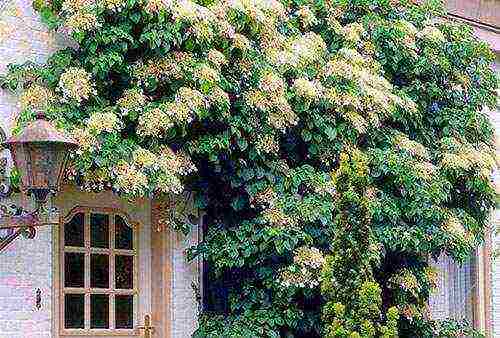 |
| Miranda | Reaches a height of 10 m. Differs in wide leaves, with pointed tips decorated with a yellowish or cream edging. There are pale white streaks in the center of the leaves. White flowers have a sweet scent. |  |
Liana can creep along the ground or envelop vertical surfaces. It is used to decorate arches, fences, facades of country houses.
The place for landing is chosen very carefully, after a few years it will be very difficult to tear off the shoots from the support on which they creep.
The optimal soil for petiole hydrangea consists of mixed in equal proportions:
- peat;
- sand;
- turf land.
Like the varieties described above, the petiole hydrangea propagates by cuttings and branches.
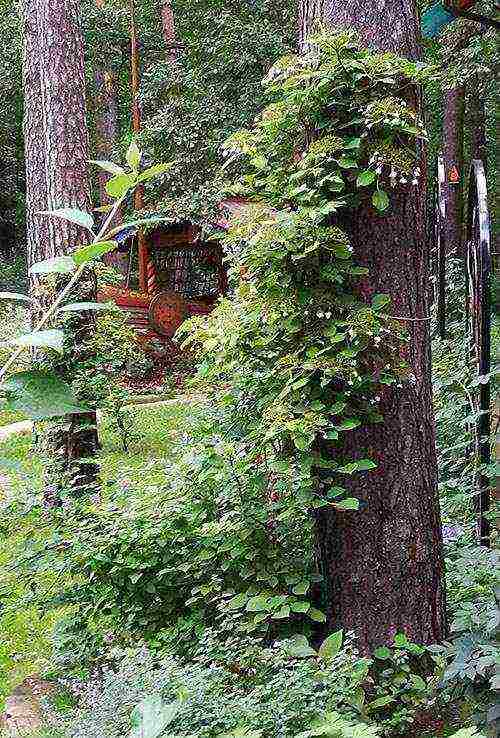
cof
To prevent the plant from freezing and getting sick, it is covered for the winter. Well-rooted plants tolerate cold quite well, but can freeze on the windy side. In this case, the flowering will not be as lush. To remedy the situation, damaged shoots are pruned in late winter or early spring.
The root system of the plant is not able to feed on its own, therefore, it is required to fertilize the soil with mineral and organic compounds 4 times a year. To acidify the soil, a mulching layer is poured from rotted leaves, tree bark, needles, sawdust.
Influence of soil composition on hydrangea color
The shade of the inflorescences depends on the level of acidity of the soil. Pink predominates in plants growing on low acidity soil, the higher the PH, the more blue is present in the inflorescences.
If you add alum or iron salts to the soil 2 times a month, the inflorescences will change their color to bluish or blue.
To achieve a change in hydrangea color, you need to increase the PH value to 6.5. When acidity is less than PH 6, a lack of iron is formed in the soil.
Hydrangea is grown to decorate houses and parks. This plant is indispensable for landscape design. The ornamental shrub exudes a wonderful honey aroma and pleases those around it with lush large flowers. Hydrangea care is not difficult, even a novice gardener can grow a beautiful bush.
About popular types of hydrangea - video

Large-leaved hydrangeas Endless Summer

For several years of my stay on the site, I met questions in which people often asked why their hydrangea does not bloom or how you can change its color. The correct answer, and even in a nutshell, can be difficult to give if you do not know what kind of hydrangea we are talking about. Often a person buys a plant without knowing the variety, not knowing its genetic predisposition and not always understanding how it will grow in its specific conditions and on its specific soils.
I myself have been dealing with these issues for a long time and now I decided to share some of my knowledge and my modest experience with you.
There are five main types of hydrangeas
which are grown in gardens: paniculate, treelike, petiolate, ground cover and large-leaved. Large-leaved hydrangea (lat.
Hydrángea macrophýlla
) are also called "broadleaf", "garden" and "macrophile".
This post will talk about large-leaved hydrangeas - macrophiles,
blooming on the shoots of the current year
that grow in our garden near Moscow.
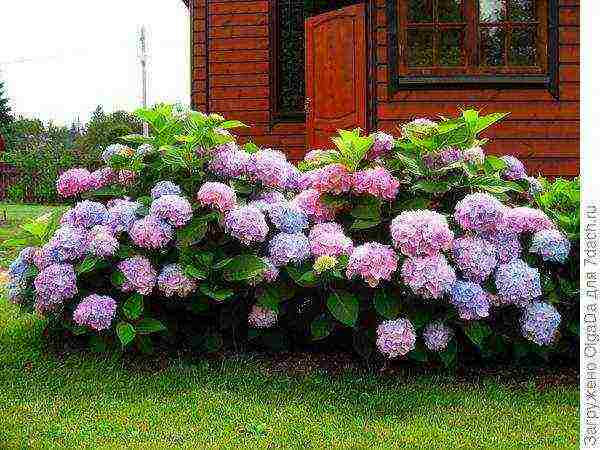
Large-leaved hydrangeas Endless Summer
I will tell you about my experience in growing these wonderful flowers. I will tell you about the successes and failures that I had to face, and thanks to which I gained my personal experience.You can successfully grow macrophiles if you understand the nature of these plants.
In regions with warm winters, there are no problems with growing and flowering large-leaved hydrangea, but our winters make their own adjustments to the growing conditions for these wonderful flowers.
The first unsuccessful attempts to grow these beautiful flowers in the garden were made by me 20 years ago. These were large-leaved hydrangeas that bloomed
on the shoots of last year
and which, in spite of all my tricks with the shelter of plants for the winter, refused to bloom in the summer. The problem was the preservation of flower buds in winter. In these macrophiles, a flower bud, laid down this year, blooms only for the next (second) year, which is just what it is difficult to preserve in winter. The tops, where the flower buds are located, are the most immature part of the plants, and in winter they often froze over and they had to be cut off along with the dead flower buds.
However, world selection does not stand still and in recent years large-leaved hydrangeas have appeared on the market, blooming on
shoots of the current year.
With the advent of these varieties, most macrophile lovers have a real opportunity to see their lush bloom in their garden.

Large-leaved hydrangeas Endless Summer
In these macrophiles, a flower-bud, laid on a young shoot in spring, blooms in the same year in the second half of summer. This aroused great interest in them, since there was no need to preserve the entire shoots at all costs in the winter. Even if in winter it is not possible to preserve the entire shoot and in the spring it is necessary to remove the dead part of the plants, then after such pruning from the sinuses of the remaining lower part of the old shoot, young shoots of the second order with flower-buds begin to grow, which will bloom in the same year.
In addition, these new varieties of macrophiles blooming on the shoots of the current year, as a rule, have increased winter hardiness (up to -30˚).
However, frost resistance up to -30˚ refers to frost resistance
root system
but not to flower buds. They also freeze, like all other macrophiles. But the aforementioned varieties have a much faster flower bud ripening rate than other varieties. The bud, formed in the spring on the shoot of the current year, has time to ripen and bloom by the end of the same season. That's the whole trick.
At the dawn of my fascination with macrophiles, I accidentally came across a book about the cultivation of hydrangeas by an American author, Dr. Michael Dirr from University of Georgia, which in many ways helped me understand these plants and find a common language with them. The author of the book is called “
Hydrangea guru
"- Guru in the field of hydrangeas. It is a pity that we do not sell these books in translation yet, there is a lot of interesting and useful information on growing hydrangeas.
Chromaticity macrophile
The chromaticity of macrophiles depends on their genetic predisposition.
Genetically red and white hydrangeas do not change color
... That is, you cannot make red from red or make red from white. Depending on some features of the soil and air temperature, these hydrangeas can only change the color saturation. In addition, as the flower ages, the color from red (at the beginning of the season) may change to red-purple (at the end of the season).
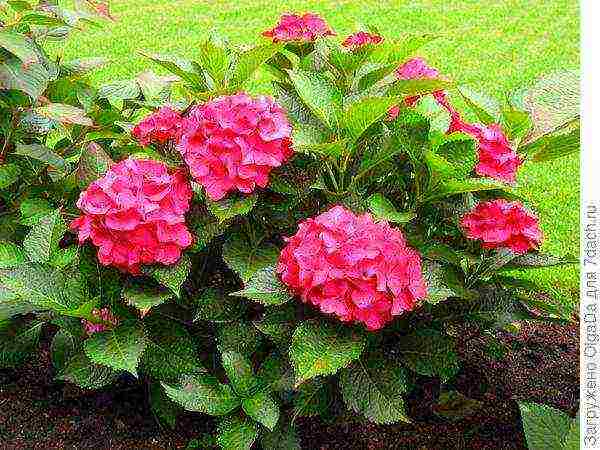
But those hydrangeas that were originally pink or blue can change color in one direction or another.
The color of such hydrangeas is affected by:
- soil acidity (pH)
- the presence or absence of free aluminum in the soil
- the presence of soluble iron in the soil
It is very difficult for a non-specialist to understand the chemical processes in the soil, for this there are “smart” people who write “smart” books, and we, gardeners, have to trust them and check their conclusions in practice in our garden.
“The lowest levels of soluble iron (assimilable) are found at alkaline pH values.Therefore, acidic soils are more enriched in soluble inorganic iron than neutral and alkaline "(Kabata-Pendias, Pendias, 1989" Trace elements in soils and plants ").
Since there is little soluble iron in alkaline soils, and aluminum in an accessible form is practically absent in them, hydrangeas in such soils will be pink. At the same time, due to a lack of iron, they can suffer greatly from chlorosis.
In acidic and slightly acidic soils, more enriched with soluble inorganic iron, aluminum in an accessible form can be either a lot or a little. If there is a lot of aluminum, the flowers will be blue-blue, and if there is little aluminum, the hydrangea will show pink or a mixture of pink-blue flowers.
Simply put, in order to get a blue hydrangea from a pink hydrangea, you need a combination of acidic soil and the presence of aluminum and iron ions in the soil in an easily assimilated form. Aluminum helps the iron to go into a soluble state, thereby enabling the plant to assimilate it. In other words, in order for the pink hydrangea to turn blue, you need to lower the soil pH, add aluminum sulfate (aluminum alum) and iron chelate (for example, Ferrovit). You can also use special fertilizers for blueing macrophiles.
To get pink hydrangea from blue hydrangea, it is necessary to increase the pH of the soil, but this is fraught with chlorosis.
In general, hydrangeas can grow in soils with different pH - from acidic to neutral and even slightly alkaline. But on the latter you will have to try very hard and run around "with tambourines".
It is good to change and maintain the desired color of macrophiles when grown in a pot culture. In the garden, due to the leaching of trace elements from the soil, this is more difficult to achieve, it is necessary to constantly maintain the desired pH of the soil and introduce the necessary trace elements. It is quite difficult to get very blue from a pink macrophile, as they sell in a garden center. My color changes, but not so much. More often the bushes are in pink-blue and pink-lilac shades.
Macrophile with pink flowers on one side of the bush.

Macrophila with pink flowers on one side of the bush
A macrophile with lavender flowers on the other side of the bush.

A macrophile with flowers of different colors looks very attractive and picturesque.

Large-leaved hydrangeas Endless Summer
If someone grows a blue-blue hydrangea in the garden without any tricks, this means that they initially have acidic soil in the garden with the necessary content of aluminum salts and iron ions in it.
I once planted Endless Summer blue hydrangea. Our soils are sod-podzolic, slightly acidic, and in the first year after planting, it bloomed with beautiful blue caps.
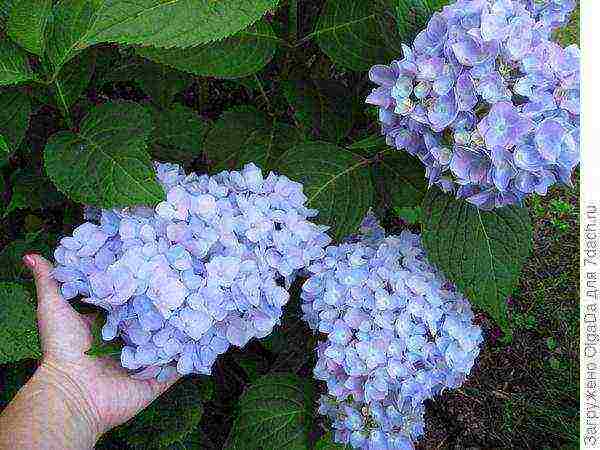
Large-leaved hydrangea Endless Summer
The next year I had to transplant it, and it immediately bloomed with pink flowers. And this despite the fact that I prepared acidic soil for planting. I realized that only acidic soil by itself does not provide a blue color, iron and aluminum ions are needed. Cuttings from blue hydrangea, planted in regular garden soil, also bloomed with pink flowers.

Blue hydrangea, after transplant, bloomed with pink flowersPlanting and leaving
It is better to plant macrophiles in the sun, but remember that these are very moisture-loving plants and you will have to water them much more often and more abundantly in the sun. Here they grow where the sun is from lunch to evening. It happens that on very hot days, even their flower "caps" hang, but in the evening after watering they quickly recover. I want to try to solve this problem by planting in a substrate with a hydrogel.
Macrophiles, despite their small stature, have a large root system. I found out about this when I needed to transplant a 5-year-old bush to another place. There were no assistants at that moment. I decided that I can handle it myself. Having dug in the plant, I could not pull it out. It turned out to be overwhelming for me. Then a "little mouse" came running to my aid in the form of a healthy man-neighbor, and together we pulled out this "turnip".He dragged the bush onto a sheet of iron and on this sheet he dragged it to a new planting site. Since then, I have not been transplanting adult bushes. And I prepare holes for new plantings ~ 60 cm wide and ~ 50 cm deep.
I prepare an acidic substrate for my hydrangeas. I usually put a mixture of high-moor peat, sand, humus and leafy soil or forest litter into the planting pit. If there is a special soil for rhododendrons, then I add that too. I added a complete mineral fertilizer to the soil mixture and added colloidal sulfur to ensure a longer acidification of the soil (1 sachet - "Teovit Jet"). Since I like to have flowers of different shades on one bush, I also added iron chelate - this is the drug "Ferrovit" (1 sachet) and aluminum sulfate - these are aluminum alum. I buy aluminum alum in a pharmacy, it is a remedy for eliminating sweating))) and is called "Burnt alum".
I water the planted bush well and mulch it with coniferous litter from the forest, since it is a summer cottage in the forest. Mulch is needed to keep the soil moisture. In the future, I try to water it with acidified water.
If the plant is potted, then I plant it in the same way as rhododendrons, after soaking the roots in water and spreading them.
I try to water it with rainwater from a barrel or acidified water with the addition of apple cider or 9% vinegar (30-40 ml per bucket), citric acid (3-4 g per bucket of water), etc.
To maintain the blue color on the flowers, no more than 1 time a week I water them with a solution of aluminum alum (1 tablespoon per bucket of water) or special fertilizers for blue hydrangeas (according to the instructions).
As necessary, I feed the plants with fertilizers with microelements. I try to buy instant fertilizers made specifically for hydrangeas.
Just like with rhododendrons, once a year, in the spring, under an adult bush (around), I pour 1 packet of colloidal sulfur - "Teovit Jet".
With such agrotechnology, chlorosis does not occur in plants. But if someone's plants grow on neutral or even weakly alkaline soils, then in case of chlorosis, they must be watered with acidified water with the addition of aluminum alum. Alum helps the iron in the soil go from a bound state to a digestible state. You can also add phosphorus-potassium fertilizers.
Wintering macrophile
As I already wrote, the frost resistance of the root system in those macrophiles that grow in our garden up to -30C, but this does not apply to flower buds. I cover hydrangeas in October, without waiting for severe frosts. I cut off all the flowers and leaves (I do this not in one go) and then, I pin the shoots to the ground in thin arcs, placing pieces of lutrasil under the arcs so that the iron does not touch the branches. Bending down the shoots, I tie them into bundles with a ribbon and lay them out on two sides (left and right), that is, it turns out, as it were, a line. I put arcs along the line and cover with double lutrasil. I tried to leave macrophylls to winter with foliage - I didn't like the result, all the stems under the shelter were covered with slippery, rotten leaves. I open it in the spring when the threat of frost has passed. Freshly opened hydrangeas are not very presentable, but you should not be intimidated.
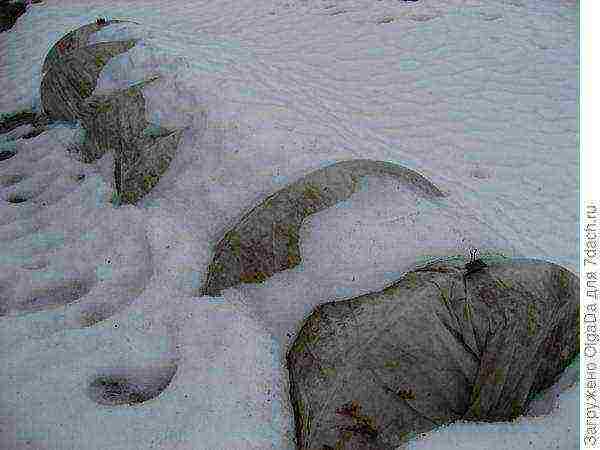
Macrophile winter shelter Immediately, after opening the plants, I do not perform any pruning. I wait until the buds begin to move forward, then it becomes clear which part of the shoot has overwintered and which has not. I usually have to trim the tops to the first (top) strong green bud. And as I already wrote above, from the axils of the remaining lower part of the shoot, young shoots begin to grow, which will bloom in the same year.
Regardless of what sellers or manufacturers say about the variety, in the conditions of central Russia, macrophiles must be sheltered for the winter.
As an example, I will give a couple of cases from my own practice.
A few years ago, I came to the dacha for a weekend in early May, opened the hydrangeas to see how they overwintered.They were in normal condition, the kidneys had awakened and already started to grow. While I was going about my business, I decided to leave them for several hours without shelter for ventilation. But just before leaving, friends came in and, distracted from my daily affairs, I completely forgot to cover the bushes back. I got into the car and drove away. And on weekdays there was a severe frost. This frost killed all the awakened buds, and the stems died with them. For dormant buds, frost is not terrible, but for those who started the growing season it turned out to be fatal. The bushes themselves did not die, but they took a long time to recover from the root, spending all their strength on it, and as a result, at the very end of summer, they gave out a couple of small flowers.
In the case of a snowless winter, even those covered with double lutrasil, the kidneys may die. I also have my own sad experience. For the kidneys, it is not so much frost that is terrible as fluctuations in temperature, the transition from plus to minus and vice versa, when the kidney cannot "fall asleep."
This is how the dead stems of Endless Summer macrophylls looked in the snowless winter 2015-2016.
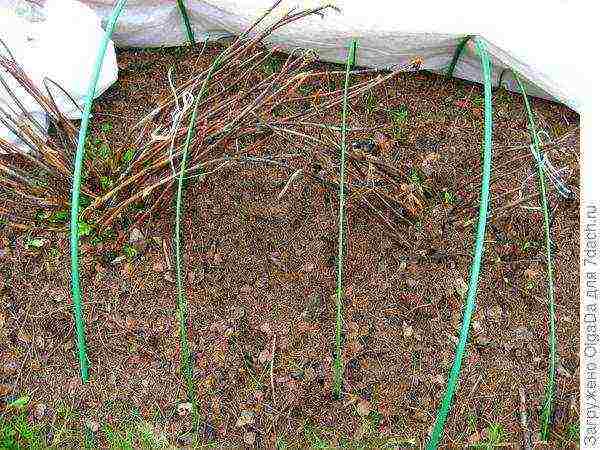
Dead stems of Endless Summer macrophylls in the snowless winter 2015-2016 By the end of summer, hydrangeas fully recovered, new shoots grew from the root, but did not bloom.
I hope someone will find my experience of growing large-leaved hydrangea in a garden near Moscow useful.
I myself continue to study, update my knowledge and follow with interest the experience of other gardeners, but experience most often comes through the "rake". It’s not without reason that A.S. Pushkin wrote: "And experience is the son of difficult mistakes."
Hydrangeas are a whole type of tree-like shrubs with large decorative inflorescences. They are often used to create hedges and other landscape design elements.
One of the most prominent representatives is Bluebird serrated hydrangea, known for its winter hardiness and the beauty of the inflorescences.
Description of Bluebird serrated hydrangea
Hydrangea serrata varieties Bluebird was bred in Japan... The plant itself is a shrub with a strong, branched trunk, ranging in height from 100 to 120 centimeters.
The crown can grow up to 1.5 meters wide. The leaves have a rich green color and oval shape, they have jagged edges at the edges.
The caps of the inflorescences are shaped like a flat umbrella and can reach 10 centimeters in diameter. Inside are located small pink or purple flowers with blue stamens.
At the edges, the flowers are already larger, they are characterized by a color from light purple to bright blue.
The color of the inflorescences can change depending on the quality of the soil, if it is acidic, then the petals will be painted in sky blue instead of bright blue.
An interesting feature of the variety will be shallow roots, only 40-45 centimeters. With proper care, this shrub will bloom from July to September.
Also Bluebird refers to winter-hardy shrubs and can withstand temperatures down to -20 degrees.
Advantages:
- gorgeous appearance and unusual shade of inflorescences;
- good frost resistance;
- immunity to pests and most diseases.
Flaws:
- high level of occurrence of the root system;
- whimsy to the composition of the soil and the quality of care;
- fear of direct sunlight.
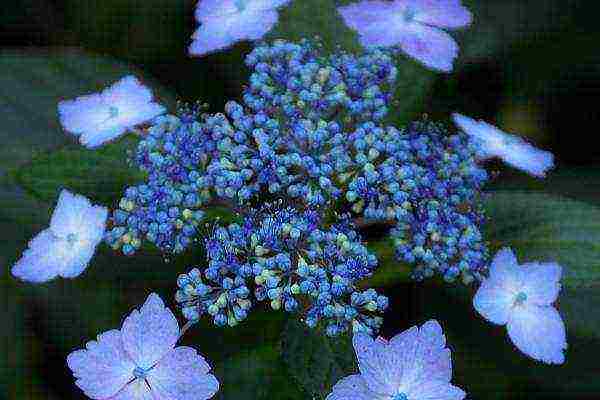 Advantages of the variety: winter hardiness, chic appearance and unusual shade of inflorescences
Advantages of the variety: winter hardiness, chic appearance and unusual shade of inflorescences
Landing
Experienced gardeners recommend plant serrated hydrangea in late April-early May or mid-Septemberwhen the temperature regime becomes more moderate.
When choosing a place, it should be borne in mind that this species prefers to receive sunlight in a diffused form. You can also plant a shrub in partial shade.
On average, the dimensions of the pit will be 50 centimeters in width and depth. While digging the soil into it the following fertilizers are applied:
- 2 parts of humus;
- 2 parts of leafy soil;
- 1 part peat;
- 1 part sand;
- 20 grams of urea;
- complex mineral fertilizers according to the instructions.
If you compose any composition of hydrangeas, it should be borne in mind that the distance between them must be at least 1.5 meters.
During landing the root collar should be flush with the ground... After the seedling is in the ground, it must be watered and mulched.
 This species prefers to receive sunlight in a diffused form, you can plant a shrub in partial shade
This species prefers to receive sunlight in a diffused form, you can plant a shrub in partial shade
Care
Caring for Bluebird Saw Hydrangea is very easy... The main thing to consider is that the plant is very fond of warmth and moisture, so it is recommended to water it every day.
Also, if the air temperature rises to 25 degrees, the soil is moistened twice a day, and if more than 30 degrees, then three times.
The ground around the shrub should always be moist, otherwise it may start to grow more slowly and bloom is no longer so bright and colorful.
So that the root system gains access to oxygen and moisture faster, it is necessary to loosen the ground near the bush... But it should be borne in mind that this variety has a very high occurrence of roots and deep loosening is contraindicated for it.
In addition to timely watering, care must be taken to ensure that the shrub is not harmed by direct sunlight at midday. For this it is necessary to create artificial shading using a removable canopy etc.
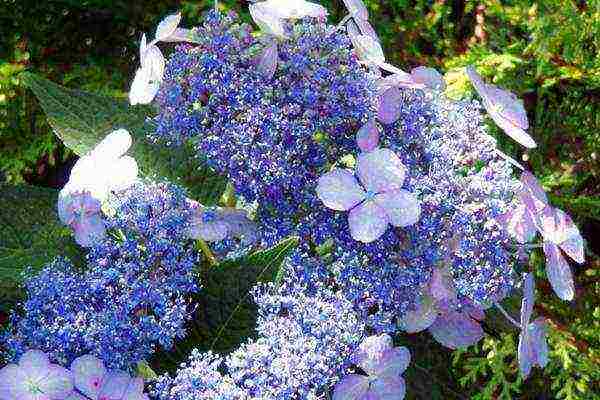 Care includes watering, shallow loosening and shading
Care includes watering, shallow loosening and shading
Hydrangea is fertilized according to the following scheme:
- During the formation of buds and immediately after flowering, the shrub is watered with a mixture of a kilogram of peat, a kilogram of dry leaves and 500 grams of humus, which are then diluted with 2.5 liters of infused water.
- Then, during the entire flowering, compost or dry foliage is added once a week to the root zone.
Hydrangea does not tolerate fertilizers such as lime, wood ash or chalk, so their use is contraindicated.
Handle nitrogen fertilizers carefully, with an overabundance of them, the flowering will be very abundant and can damage the shrub itself. Therefore, urea or rotted manure is applied only at the beginning of the growing season in moderation.
In addition to watering and feeding, serrated Bluebird hydrangea requires annual pruning, the best time for it is autumn.
In the course of work, dry, weak, uneven and dead shoots are removed. You should also clean the shrub from the remaining foliage and faded inflorescences.
To stimulate the growth and flowering of the plant, all shoots are cut into 2-3 buds.
Care for serrata hydrangea:
Growing problems
Bluebird serrata hydrangea lends itself very well to cultivation even among beginners. The main thing water, fertilize and protect the shrub from direct sunlight on time.
Usually, gardeners find it difficult to loosen the soil because the roots are very close and can be easily damaged.
To avoid situations like this the earth is loosened to a depth of 4-5 centimeters.
Preparing for winter
Bluebird serrated hydrangea enough tolerates cold weather well in central Russia, but it is necessary to build a shelter until the plant gets stronger, that is, up to 4-5 years.
Also, you will have to protect the shrubs for the winter in the northern and cold regions.
The work is carried out adhering to the following rules:
- First you need to do sanitary pruning.
- Then phosphorus and potash fertilizers are scattered under the bush.
- In frosts down to -5 degrees, the shrub is spud and covered with polyethylene.
- Up to -15 degrees, the hydrangea is tied with a rope, spudded, covered with spruce branches, and a film is wound on top.
- At temperatures up to -20 degrees, the branches are bent to the ground and fixed with metal brackets, sawdust, coniferous branches, old blankets, etc. are placed on top.
- In frosts down to -30 degrees, the shrub is wrapped in a metal grate, covered with bricks and covered with old warm clothes on top.
If you correctly prepare the hydrangea for winter, then in the spring the plant will start growing faster.
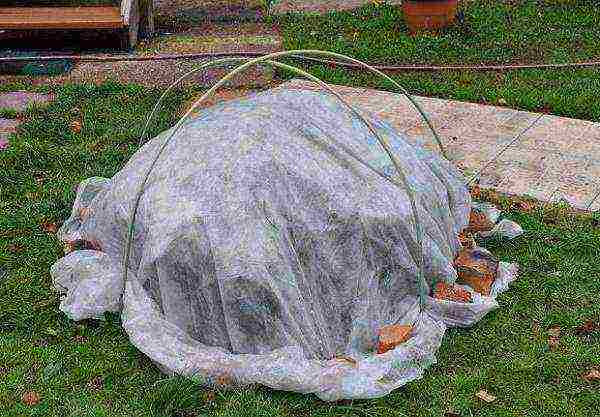 It is necessary to protect shrubs for the winter in the northern and cold regions.
It is necessary to protect shrubs for the winter in the northern and cold regions.
Diseases and pests
Bluebird serrated hydrangea is resistant to almost all pests. Most often it is affected by Chlorosis or Powdery Mildew.
With chlorosis the leaves of the plant begin to lighten, while the veins do not change color. As a treatment and prevention, hydrangea is treated with a mixture consisting of 4 grams of potassium nitrate, 4 grams of vitriol and a liter of water.
When powdery mildew appears brown spots and a silver coating appear on the leaves. An effective control measure will be a solution of 10 grams of laundry soap and 2 grams of copper sulfate, diluted in a liter of water.
Regular spraying of the shrub with insecticides will be a good prevention.
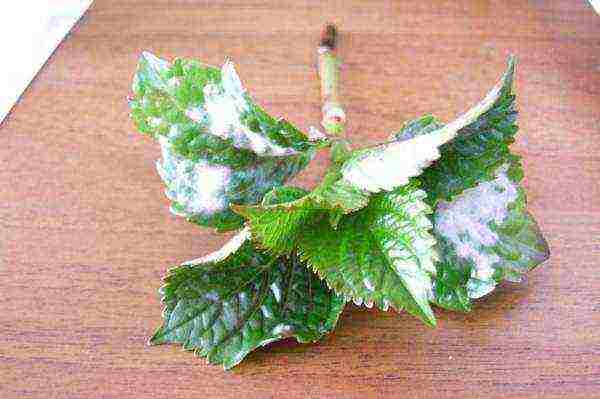 Bluebird serrated hydrangea is resistant to pests, but is affected by chlorosis and powdery mildew
Bluebird serrated hydrangea is resistant to pests, but is affected by chlorosis and powdery mildew
Bluebird serrated hydrangea can be a decoration of any garden: its lush inflorescences will be visible even from the farthest corners.
Although this shrub requires a lot of attention, its cultivation will leave only positive emotions behind.

